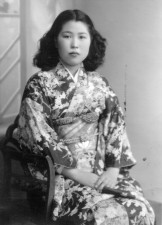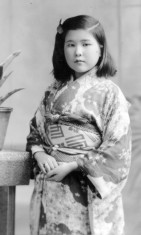Takeko and Hinako kept in touch with their family in America through frequent letter writing, but mysteriously their letters started to be returned without any explanation near the end of Showa 15 (1940). About this same time they heard rumors that people were not being allowed to return to the U.S. The girls had had no real concept of the expanse which separated Japan and America. At first they thought they could easily return to their father and family in the U.S. as soon as possible, even "next Saturday," but as time passed the realization of their predicament became clearer to them.
The week beginning December 8, 1941 was surreal for the Yamamoto girls (December 7th in the United States was December 8th in Japan which is across the international dateline from the former). At school, Takeko and her classmates were given small, hand held Japanese flags and told to march in a victory parade through town to celebrate the attack. Then the military police came to Grandmother Yamamoto's home and confiscated a small American flag and any documents, papers or books that they could find which were written in English. They even confiscated some Bing Crosby records and newspapers that had been sent to Hinako by an older sister because it had doll cut-outs that Hinako was particularly fond of. It had become clear that they may never be returning home. They may never see their family or America ever again. Moreover throughout the war they had to work to prove that they were Japanese while keeping their feelings about America and the war secret even from their grandmother who believed that Japan was the country of God (Emperor Hirohito) and that Japan could never lose a war. Beginning with this farewell week when the world was turned upside down, Takeko and Hinako would cry in secret and try to console each other when they could. Their strength, what helped them through the contradictions of their lives during the war, was their hope that they could someday return to America.
At times, Takeko and Hinako heard propaganda that the Japanese in America were having their noses and ears chopped off by the Americans, but they didn't believe these outlandish stories. Though they were born in America, they were not harassed too often because they looked Japanese, had Japanese names, and spoke Japanese fluently by the time the war had started, but it did occur. Some of the other kids would call these girls from America "whites" or some other derogatory names. When the American B-29s were dropping bombs, some would say "those might be flown by your brothers." The kids who said these things seemed to feel sorry afterwards, but the pressure to blend in was enormous.

Iwata Toshiko, Hinako's classmate from Jogakko.
During New Year's Day or during a wedding, girls would wear beautiful kimonos like the one Toshiko is wearing here. Hinako and Takeko had several kimonos for such occasions.
|
Despite the fact that being Americans made life in Japan difficult at times, simply being Japanese during the years surrounding the war was an extreme hardship in itself. After the second year of the war with the U.S., rationing was implemented in Hashirano for such essential items as shoes, clothes, and food. The zori that Hinako made were a helpful alternative to new shoes and they could be replaced anytime it was desired.

Okada Etsuko, another classmate from Jogakko.
Okada san had a beautiful voice leading her to be chosen frequently to sing solo in music.
|
Rationing for other goods could not be so easily remedied though and this added to the difficulties that had already confronted them before the war. Produce was confiscated by the village elders for "equal distribution" based on the number of individuals in each household. Grandmother Yamamoto and the girl's Uncle Akimoto had the largest holdings of land in the village, but this meant nothing during the war. Grandmother Yamamoto no longer received bushels of rice in payment for the extensive land holdings she possessed (which included land on three mountains!). She was now given a small, ten-day ration of rice which she had to share with her two granddaughters. They would divide it into ten individual portions only to look at one of these small handfuls, probably no more than a quarter of a cup, which they had to subsist on for an entire day (rice fills the role in Japanese meals which may be filled by either bread, potatoes, stuffing, or rice in a comparable American meal). On several occasions, Takeko would get rice from the black market. She would go to a farming area that was known for its rice cultivation so she knew she could barter for rice there. There she would exchange a kimono (a traditional Japanese robe worn as everyday wear by both men and women until the second decade of the Twentieth Century) that was in good condition for one issho of rice. This was about as much rice as she could hide in her obi (a wide styled sash for the kimono) to bring home. Other times the girls would sell kimonos to a seamstress in the village for hard currency until there were none left in the household.
The sugar ration was a meager three tablespoons for one month. This they could do little to change, but salt was something they could work to supplant. Hinako and one of her classmates would tie two empty sake (rice wine) bottles, about four liters in size, together and sling them over their shoulders with one hanging on their front and one on their back before taking a forty-five minute train trip followed by a forty-five minute walk to the coast where they would wade in the ocean to fill the two bottles with sea water. After returning home, the water was boiled to kill any bacteria and used in place of table salt.
On their one day off from school, Sunday, Takeko and Hinako would help Grandmother Yamamoto with raising their own vegetables to supplement their diet with taro root, potatoes and yams. Hinako would beg her neighbors who owned a sake brewery, to allow her to pick peas from their plants. After the peas were eaten, the pea pods were saved to be ground and eaten later as well. In Fall, they would gather mushrooms, which were taken to a canning factory for cash, and pick chestnuts to sell. There wasn't much to buy with the little cash they earned because most of the stores were closed down by this time. In the Springtime they would go to a bamboo forest and dig for bamboo shoots. They would fish in a nearby river whenever they could and submerge baskets during the Summertime to trap eels. Sometimes they picked edible dandelions and azaleas which could be found at the base of hills. In the most difficult times, Grandmother Yamamoto would call the girls to pick nana kusa (the seven [edible] weeds) and they would briefly boil them until they bulked up into a stew that would fill their stomachs. They were fortunate that various foods could be found on the land they owned, but their ability to grow foods and secretly hide these foods was severely restricted by the fact that they had no men to help them.
Hinako worked in the garden along with her sister and grandmother and the harvest was all given to the village elders in spite of the fact that they could not produce much. Other families had a male head of household and the means to hide a portion of their harvest, but not the two girls and their nearly crippled grandmother. Every night Grandmother Yamamoto and her two granddaughters would lay down on their futons (Japanese style bed) in a "T" formation with their feet joined together on the top of the kotatsu (a small radiator filled with hot embers of wood or coal) hoping that they would fall asleep before the heat was all gone. In the pitch darkness of the cool country evening, Hinako snuck out of the house and after hiking for several miles to reach their fields, she dug up some of their potatoes to bring back home [Hinako had plowed these fields herself by walking backward with a plow in her hands; some of the other villagers had horses that they would harness their plow to]. Grandmother Yamamoto never questioned Hinako because she knew why her granddaughter was "stealing" the potatoes, but Hinako still felt like a criminal even though they were produce from her own garden.
In the small village of Hashirano, village elders managed local affairs. These village elders required a representative from every household to participate in village meetings and other matters concerning the community. Takeko's schooling caused her to spend increasing amounts of time in Iwakuni and Grandmother Yamamoto's mobility was limited by her arthritic knees. As result, Hinako became the household representative for many community affairs even though she was only in her fourth year of Shogakko. The elders never said that Hinako was too young to attend the village meetings, but the fact that she was filling the role most adult men held, gave some school bullies another reason to tease her with "your father doesn't love you that's why he left!" These meetings were held in a village elder's house where the shoji screen walls had been removed from the interior house to create one big room and Hinako would sit in the back of the room where she could be inconspicuous as she passed the time during the boring meetings by reading.
During the war rationing, the village elders would organize the community to collect rice from farmers in an adjacent rice growing region. Hinako represented her household on some of these expeditions which included some fifty other villagers. They would hike up narrow mountain paths to a neighboring village where they were given rice which they carried back to Hashirano on their backs.
Hinako's responsibility to the community as the representative for her household also led her to grave digging. Whenever there was a death in the village, one member from each side of the street had to go and dig a grave in a village cemetery. Hinako's turn arrived. The bodies were put in a sitting position with the knees tied against the chest before they were put in square boxes. Hinako was in a deep hole pitching dirt up for one of these coffins when she hit something hard. When she realized it was the leg bone of someone who had been buried earlier she nearly fainted. She tried to scream but nothing would come from her mouth.
While they were students in Japan, Takeko and Hinako wore sailor outfits when attending school. They wore blue uniforms during winter, and white uniforms during the summer. Even before the Pacific War began, the Japanese people were only allowed to use a limited supply of electricity so the girls would place their pleated skirts under the futon (Japanese beds) which lay directly on top of the tatami mat floors so that their skirts would look freshly pressed for school. By this time kimonos were seen less and less frequently in public and were worn commonly only at home. The fashion was to wear a light yukata in the summer and an awasae, which had a lining, in the winter (photos from the centennial celebration of Hashirano Jinjo Shogakko, the elementary school in Hashirano, show that kimonos were replaced with the sailor outfits in Showa 5 [1930], male students exchanged kimonos for Western clothes three years earlier, but the adult males had done so sometime before).


